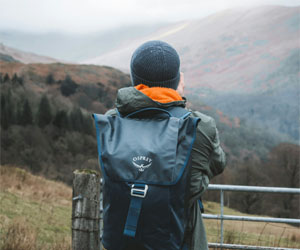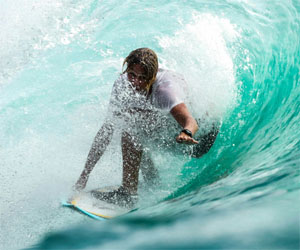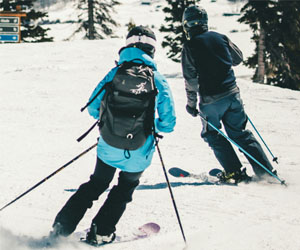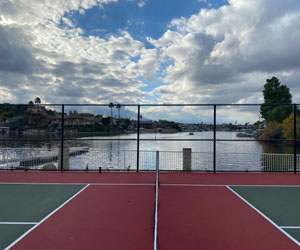


Wave Dynamics In Surfing

Surfing, often described as a dance with the waves, is an art that relies on an intricate understanding of wave dynamics. Every wave is unique, possessing its own rhythm, shape, and personality. Surfing becomes an awe-inspiring experience when you grasp the nuances of wave dynamics. In this article, we will explore the fascinating world of wave dynamics in surfing.
Understanding Wave Formation: Waves are born in the open ocean, where wind energy transfers to the water's surface. As the wind blows across the water, it imparts energy, creating ripples. These ripples grow and develop into the swells that surfers eagerly anticipate. The size of the waves depends on factors such as wind speed, duration, and the distance over which the wind travels.
Wave Direction: Wave direction is an essential component of wave dynamics. The direction from which a wave approaches a coastline or surf break significantly influences the ride. Surfing enthusiasts pay close attention to the angle at which waves approach the shore. A perfectly aligned wave can offer a long, thrilling ride, while a misaligned wave might break in a less-than-ideal manner.
Wave Period: Wave period, often expressed in seconds, refers to the time it takes for two consecutive wave crests to pass a fixed point. Longer wave periods are indicative of powerful and well-organized swells, resulting in cleaner and more rideable waves. Shorter wave periods can lead to choppy and less predictable conditions.
Wave Sets: Wave sets consist of groups of waves that arrive consecutively. In between sets, surfers experience lulls, creating moments of anticipation and readiness. Understanding the rhythm of wave sets is crucial for positioning and timing when paddling and catching waves. Surfers need to gauge the intervals between sets to be in the right place at the right time.
Types Of Waves:
The classification of waves based on their shape and breaking behavior plays a significant role in wave dynamics:
Reef Breaks: These waves break over a submerged reef or rocky bottom. Reef breaks can produce fast, hollow waves that are favored by experienced surfers.
Point Breaks: Point breaks are formed by waves breaking along a point of land. They create long, peeling waves that are ideal for graceful rides and maneuvers.
Beach Breaks: Beach breaks occur over sandy bottoms, resulting in a variety of wave shapes and unpredictability. They are suitable for surfers of different skill levels.
Rivermouth Breaks: Where rivers meet the ocean, rivermouth breaks can produce powerful and dynamic waves, often favored by advanced surfers.
Slab Waves: Slab waves are renowned for their steep, often monstrous, and barreling nature. These waves are not for the faint-hearted and require advanced skills to navigate.
Wave Behavior And Refraction: When waves approach shallower waters near the shoreline, they undergo a process called refraction. This bending of waves causes them to approach the beach at an angle, which influences how they break. Surfers must account for this phenomenon when positioning themselves in the lineup to catch the waves effectively.
Wave dynamics are at the heart of the surfing experience. Understanding how waves form, the direction from which they come, their period, and their behavior at different types of breaks is essential for surfers. It's a lifelong journey of learning and adapting to the ever-changing nature of the ocean. As surfers deepen their comprehension of wave dynamics, they unlock the magic of riding the waves with finesse and artistry, creating memories that will last a lifetime.
An Adventure Like No Other
 Challenging terrain in mountain biking can include everything from steep inclines and rocky paths to tight switchbacks and mud-soaked trails. These elements add a level of complexity and danger to the sport, making it an adrenaline-pumping experience for those who crave adventure.
Challenging terrain in mountain biking can include everything from steep inclines and rocky paths to tight switchbacks and mud-soaked trails. These elements add a level of complexity and danger to the sport, making it an adrenaline-pumping experience for those who crave adventure.
One of the key attractions of mountain biking through challenging terrain is the constant need for skill and concentration. Riders must be fully engaged in their surroundings, making split-second decisions on how to navigate obstacles. It's a test of physical strength, mental acuity, and technical prowess. The rewards of successfully navigating these difficult paths are not just the satisfaction of conquering them but also the breathtaking views and the sense of accomplishment that comes with it.
For many mountain bikers, conquering challenging terrain is a personal journey of growth and self-discovery. It pushes them to their limits and helps them break through mental barriers. Whether it's mastering a tricky downhill section, clearing a daunting rock garden, or tackling a steep climb, every challenge overcome is a victory and a testament to the rider's determination.
Safety is a paramount concern when mountain biking through challenging terrain. Riders must wear appropriate protective gear, including a helmet, gloves, and body armor. Additionally, a well-maintained mountain bike with sturdy brakes and reliable suspension is essential. It's also a good idea to ride with a buddy or let someone know your planned route in case of emergencies.
In terms of technique, riders should hone their skills on easier trails before attempting the more challenging ones. Proper body positioning, weight distribution, and braking are crucial to maintaining control and safety on steep descents and tricky ascents. Moreover, understanding how to pick the right line through obstacles and using momentum effectively can make a significant difference in successfully navigating challenging terrain.
Embrace The Great Outdoors
 Safety First: Safety should always be a top priority. Research the potential risks associated with your chosen adventure, and learn how to mitigate them. For example, if you're hiking in the wilderness, it's crucial to understand navigation, wildlife safety, and first aid. Carry a first-aid kit and let someone know about your plans, including your estimated return time.
Safety First: Safety should always be a top priority. Research the potential risks associated with your chosen adventure, and learn how to mitigate them. For example, if you're hiking in the wilderness, it's crucial to understand navigation, wildlife safety, and first aid. Carry a first-aid kit and let someone know about your plans, including your estimated return time.
Start Small: It's perfectly fine to start with shorter and less challenging trips. Many wilderness areas have well-marked and maintained trails suitable for beginners. Gradually work your way up to more strenuous and remote adventures as your skills and confidence grow.
Leave No Trace: An essential principle for beginners in the wilderness is Leave No Trace. This ethic involves taking care of nature by minimizing your impact. Always pack out what you pack in, dispose of waste responsibly, and respect wildlife and their habitats.
Learn From Experience: Experience is the best teacher when it comes to wilderness adventure for beginners. Embrace each trip as an opportunity to learn and improve.
Your Path To Slope Success
 2. Wear Appropriate Clothing: Dress warmly and in layers to stay comfortable on the slopes. Wear moisture-wicking base layers to keep sweat away from your skin, insulating layers to trap warmth, and a waterproof and insulated ski jacket and pants to protect against the cold and snow.
2. Wear Appropriate Clothing: Dress warmly and in layers to stay comfortable on the slopes. Wear moisture-wicking base layers to keep sweat away from your skin, insulating layers to trap warmth, and a waterproof and insulated ski jacket and pants to protect against the cold and snow.
3. Choose The Right Equipment: Renting skiing equipment is a practical option for novices, as it allows you to try different gear without a significant investment. Make sure your boots are well-fitted, and your skis are suited to your skill level. Ski shops and rental centers can provide expert advice.
4. Master The Snowplow (Pizza) Technique: The snowplow, often called the "pizza" technique, is the foundation for beginner skiers. To snowplow, point the tips of your skis inward, creating a wedge shape. This position slows you down and helps you control your speed. As you progress, you can start making parallel turns.
5. Learn To Turn And Stop: Turning and stopping are fundamental skiing skills. Practice turning your skis by shifting your weight from side to side, and learn to stop by bringing your skis together and applying pressure to the inside edges. These skills will give you control and confidence on the slopes.
Recovery Techniques For Sports Injuries
 1. Rest And Immobilization: In the immediate aftermath of an injury, one of the first recovery steps is often rest and immobilization. Rest allows the body to begin the natural healing process, and immobilization can help prevent further damage. This may involve the use of braces, slings, or casts.
1. Rest And Immobilization: In the immediate aftermath of an injury, one of the first recovery steps is often rest and immobilization. Rest allows the body to begin the natural healing process, and immobilization can help prevent further damage. This may involve the use of braces, slings, or casts.
2. RICE Protocol: The RICE protocol is a well-known method for managing sports injuries. It stands for Rest, Ice, Compression, and Elevation. Rest and elevation help reduce swelling, while ice and compression can alleviate pain and inflammation.
3. Physical Therapy: Physical therapy is a cornerstone of sports injury recovery. Skilled physical therapists develop customized exercise programs to help athletes regain strength, mobility, and function. These programs often include stretching, strengthening, and functional exercises.
4. Heat And Cold Therapy: Heat therapy can be beneficial for relaxing tight muscles, increasing blood flow, and easing pain. Cold therapy, on the other hand, can help reduce inflammation and numb pain. The choice between the two depends on the type and stage of the injury.
Rules And Regulations Of Pickleball
 Court Dimensions: A standard pickleball court is 20 feet wide and 44 feet long, with a non-volley zone (the kitchen) extending 7 feet from the net on each side. The kitchen is a no-volley zone, meaning you can't hit the ball out of the air within this area.
Court Dimensions: A standard pickleball court is 20 feet wide and 44 feet long, with a non-volley zone (the kitchen) extending 7 feet from the net on each side. The kitchen is a no-volley zone, meaning you can't hit the ball out of the air within this area.
Scoring: Pickleball is played to 11 points, and you must win by at least two points. In singles, each side gets one serve, while in doubles, both players on the serving team have the opportunity to serve.
The Serve: The serving team starts the game from the right side of the court and must serve underhanded from the baseline. The serve must clear the net and land in the opposing service court, diagonally across from the server. It must also bounce once before being struck by the receiving team. The serving team continues to serve until they commit a fault.
Double Bounce Rule: After the serve, both teams must allow the ball to bounce once before they can engage in a volley (a non-bouncing exchange). This rule ensures that rallies begin with a level of control and reduces the possibility of quick, aggressive plays.
Faults: Common faults in pickleball include stepping into the kitchen while volleying the ball, hitting the ball out of bounds, failing to clear the net, or volleying the ball from the kitchen without letting it bounce. Faults result in the opposing team being awarded a point or the service.
Let Serve: If the serve hits the net and lands in the correct service court, it is called a "let serve" and is retaken without penalty.
Non-Volley Zone Violation: Players are prohibited from volleying the ball from the non-volley zone (the kitchen). Stepping into the kitchen while hitting the ball is a fault.
Serving Position: When serving, players must have one foot behind the baseline and inside the court boundaries. The other foot must remain in contact with or behind the baseline until the ball is struck.